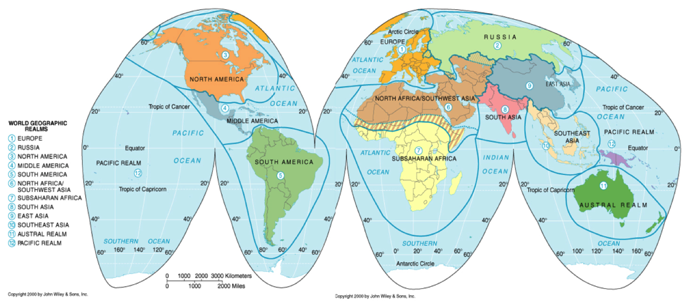Look closely at the familiar world map above and you will see that its colors represent not countries, but large regional areas that we will call world cultural realms. Some of these areas lie within countries (such as those within China, Russia, or the United States) and some of these areas include several, or even many, entire countries (Africa and Europe, for example). When geographers look at the world, its land masses, oceans, flora, fauna, myriad cultures, and 200 or so countries, commonalities persist—this is the way geographers explain the regionalization process. Geographer Harm DiBlij, among others, has written extensively about the world's cultural realms. He divides the world into 12 realms, each of which have subdivisions called regions (and even sub-regions). In time, we'll cover each of these with some degree of specific focus.
Geographic Realms
- Defining Realms: Four Traditions, Five Themes
- Four Traditions
- Five Themes
- Other Classification Systems
- Geographic Realms
- Transition Zones
- Regions
- Formal
- Functional
- Scale of Analysis
Defining Realms: Four Traditions, Five Themes
The regionalization process, from which we derive the worlds twelve cultural realms and, within each realm, a number of sub-regions, relies on all of the Four Traditions of Geography, as well as each of the Five Themes of Geography:
The Four Traditions of Geography:
- Spatial Tradition: a locational tradition—spatial unifying theme, similar patterns between physical & human geography.
- Area Studies Tradition: an area-analysis tradition‐regional geography.
- Man-Land Tradition: a culture-environment tradition - relationships between human societies and natural environments
- Earth Studies Tradition: an earth-science tradition—physical (natural) geography.
The Five Themes of Geography:
- Location: a location is a space: everything has a position, a location, on, below, or above the Earth's surface.
- Human/Environmental Interactions: cultural landscape—the sum total of all changes to the Earth and its biosphere that people make
- Region: areas of unique characteristics, ways of organizing people geographically
- area: defined spatial extent
- location: lie somewhere on Earth's surface
- boundaries: sometimes evident on the ground, often based on specifically chosen criteria
- distinctiveness:
- culture (language, ethnicity, race, religion)
- economic activity (agriculture, industry)
- physical conditions (climate, vegetation)
- Place: distinctive identity of a space
- shaped by the physical environment, or the ecology, of a space
- shaped by the changes humans have made to that space
- shaped by the interconnections (or lack thereof) among people and objects in a space
- segregation prohibits connections between people
- landforms present physical barriers
- infrastructure facilitates interconnections
- Movement: literally moving people or objects from one location to another; implies interconnections between locations
- Culture Hearths
- Sources of civilization from which an idea, innovation, or ideology originates (e.g. Mesopotamia, Nile Valley)
- Viewed over the passage of time as well as changes in space
- Cultural diffusion
- Culture Hearths
Some Other Classification Systems
Biologists
- Taxonomy
- kingdom, phylum, order, family, genus, species
- brought an order and insight to the variation among life-forms on Earth
- can also limit understanding: trying to force a new discovery into an old system has frequently meant changing the system
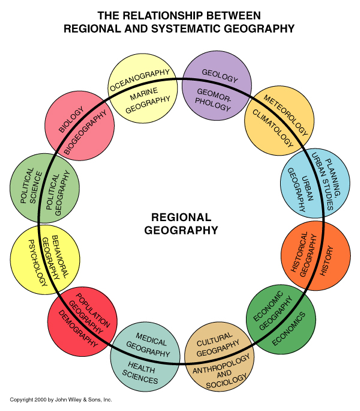
Chemists/Physicists
- The Periodic Table of the Elements
- vertical order by property (e.g. metal, gas)
- horizontal order by weight
- allowed for experimental discovery and "completion" of the Periodic Table
Geologists
- The concept of geologic time
- Thinking in the context of very long time periods is Important to understand the theory of evolution
Historians
- Eras
- ages
- periods
Geographers
- Geographic Realms and/or Regions
- Based on spatial criteria (Spatial Analysis Tradition)
- Can show insights as to why and how each place is distinctive
- Can be inaccurate—transition zones and cultural diffusion means almost all places are in a state of change (sequent occupancy)
Geographic Realms
- Realms are defined by spatial references
- Realms are the largest geographic units into which the inhabited world can be divided
- the most comprehensive and encompassing definition of the great clusters of humankind in the world today
- Based on both physical (natural) and human (cultural) features
- physical landscape
- cultural landscape
- Realms result from the interaction between human societies and natural environments
- A functional interaction
- farms
- mines
- fishing ports
- transport routes
- dams
- bridges
- villages
- other features on the landscape
Transition Zones
- An area of spatial change where peripheries of two adjacent realms or regions join
- Marked by a gradual shift (rather than a sharp break) in the characteristics that distinguish neighboring realms
Regions
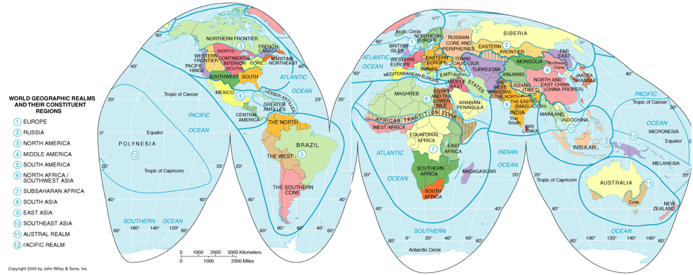
- Human (cultural) properties within realms vary
- Physical (natural) characteristics within realms vary
- Both (Man-Land & Human/Environment) within realms vary
- All regions (within realms) have
- Area
- Boundaries (or borders)
- physical
- political—some regions are formal or recognize political boundaries
- Europe's British Isles
- French Canada
- Central America
- Location (absolute and relative)
Scale of Analysis
- World
- Realm
- Region
- Place
World
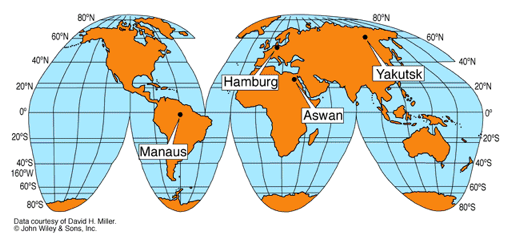
Realm
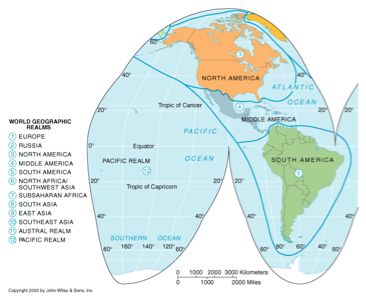
Formal Regions
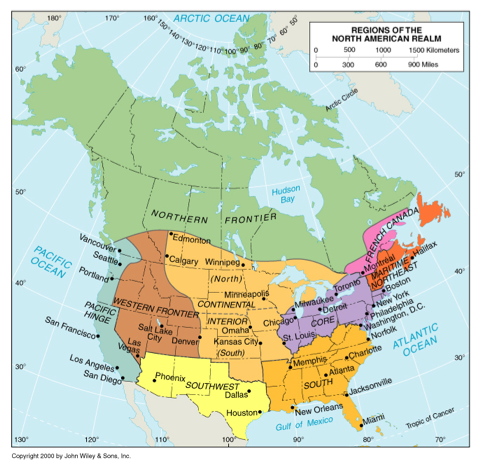
- political boundaries define formal regions
- note that the northern boundary is defined by population, however, since AP Human Geography is concerned with people and culture
Functional Regions
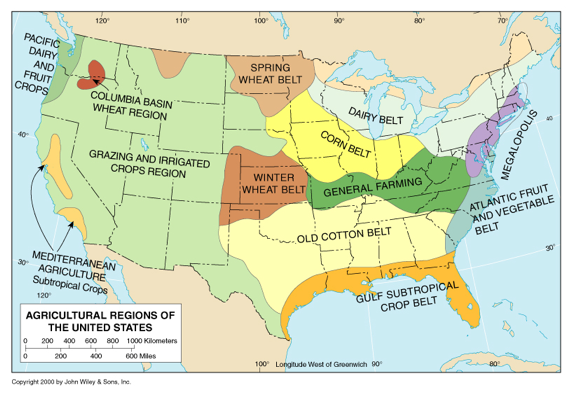
- Homogeneity in one or more phenomena
- Also called a uniform region or homogeneous region
- Several examples
- Corn Belt, Spring Wheat Belt, Winter Wheat Belt
- Grazing and Irrigated Crops Region
- A "megalopolis"
- Gulf and Subtropical Crop Belt (sugar, citrus, "row crops")
Place: Central Place Theory (Core & Hinterland)
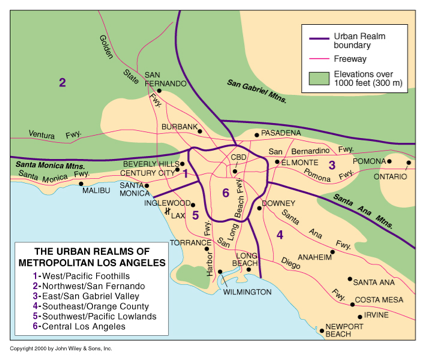
- A place (or set of places) that has dynamic internal structure
- Also called a “nodal” region or a "functional" region
- It is spatial system focused on a central core
- Core usually means an urban area (a city)
- The central core results from a surrounding landscape called a "hinterland"
- Hinterland literally means “country behind” (German origin)
- Urban center is the nexus of goods and services produced in the hinterland
- Urban center is the dominant cultural focal point
- Urban center has historically been the geographic focal point (river, lake, ocean)
World Cultural Realms & Regions
- Cultural Geography
- Cultural Landscape
- Culture Hearth
- Sequent Occupance
- Political Geography
- Nation
- State
- Nation-State
- Population Geography
Culture
- Definition: Shared patterns of learned behavior
- Components:
- Beliefs
- Institutions
- Technology
- Interactions: The composite of human imprints on the earth’s surface.
- Cultural Landscapes
- Culture Hearths
- Cultural Diffusion
- Cultural Environments
- Culture Regions
“the forms superimposed on the physical landscape by the activities of man” —Carl Sauer
Cultural Landscape
- people make changes to their spaces
- green spaces in New York City (Central Park) and Banaue, Philippines (rice terraces)
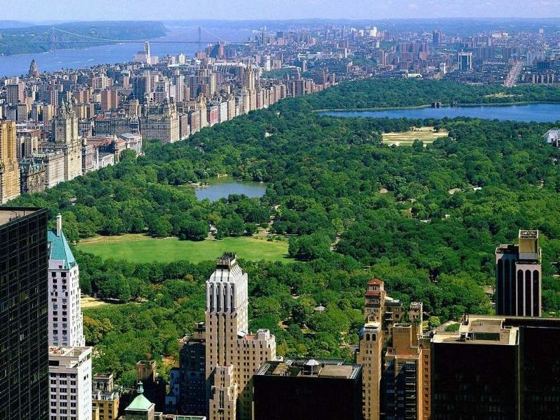
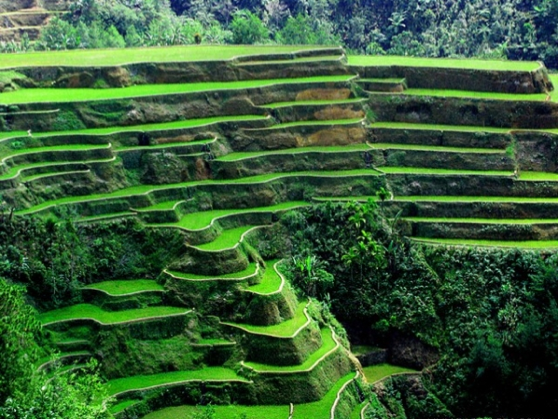
Culture Hearths
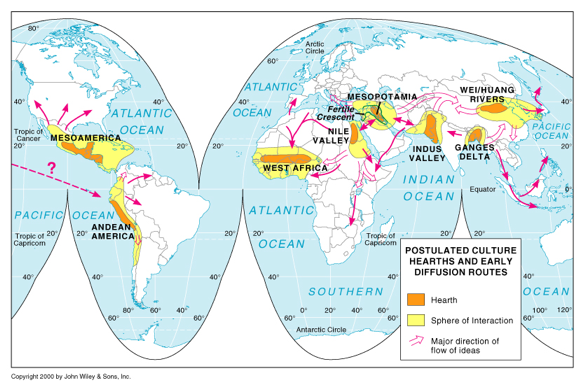
- the world's oldest civilizations originated in a handful of cultural hearths
- some of these persist to this day as distinct cultural realms or regions
World Population Distribution

- The vast majority of the world's population is distributed in a handful of concentrations:
- 4 major clusters:
- A & B - East Asia
- C - South Asia
- D - Europe
- Northeastern US
- 4 major clusters:
- 90% of the population lives north of the equator.
- 2/3s live in mid-latitudes between 20° and 60° latitude.
- >50% of the population lives on 5% of the land.
- 2/3s live on 10% of the land.
- Almost 90% live on 20% of the Earth’s land surface.
- 60% of people live below 200 meters (650 feet) in elevation.
- 80% live below 500 meters (1,650 feet).
- 2/3 of population lives within 500 kilometers (300 miles) of an ocean.
- Most inhabit alluvial lowlands and river valleys.
State
A politically organized territory Administered by a sovereign government Recognized by a significant portion of the international community. A state must also contain: a permanent resident population an organized economy a functioning internal circulation systemNations
- nations are self-identified groups of people, not lines on a map
- examples of stateless nations: the Cherokee Nation, the Kurds, the Palestinians

